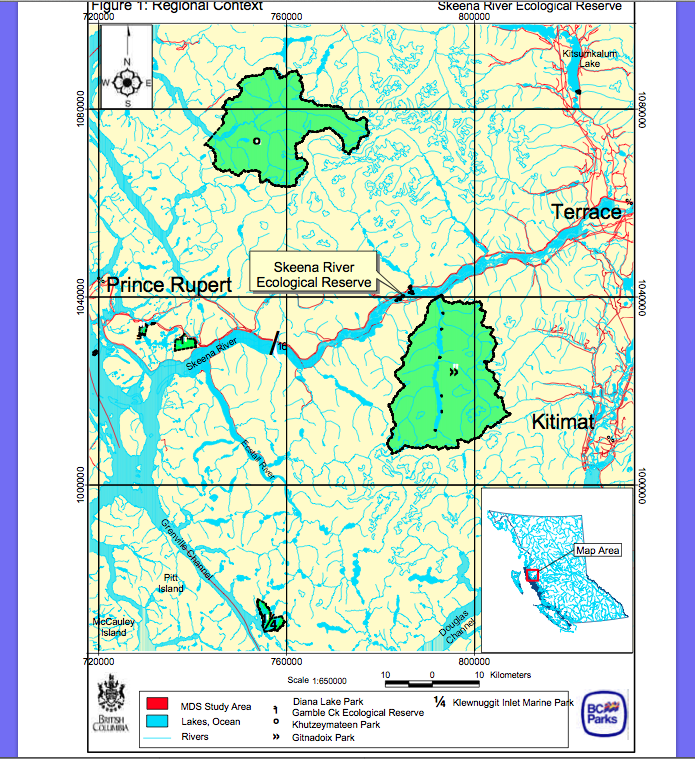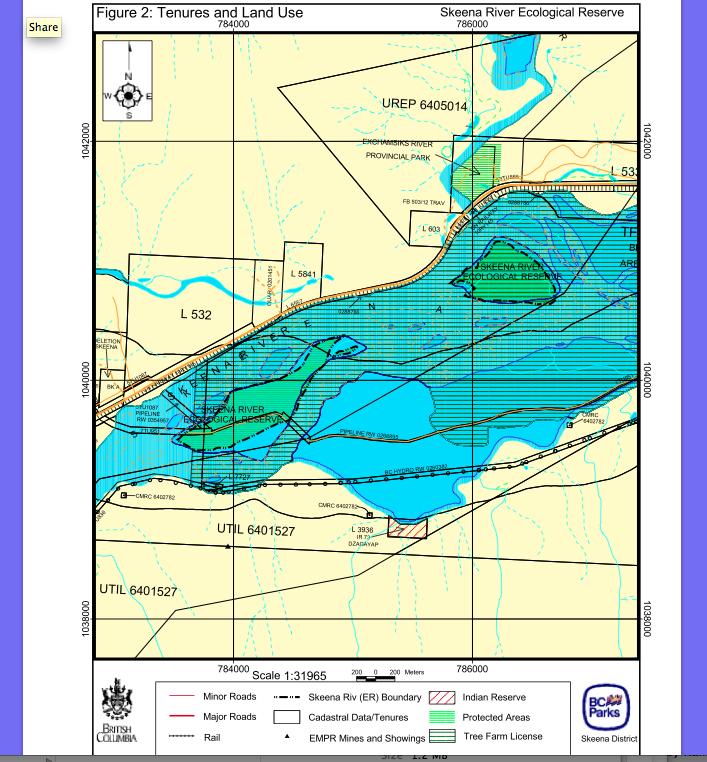
News/Reports
Skeena Area Management Direction Statement March 2003
Introduction Purpose of the MDS
Skeena River Ecological Reserve Management Direction Statement
Management direction statements (MDS) provide strategic management direction for protected areas that do not have an approved management plan. Management direction statements also describe protected area values, management issues and concerns; a management strategy focused on immediate priority objectives and strategies; and, direction statements from other planning processes. While strategies may be identified in the MDS, the completion of all these strategies is subject to funding and funding procedures. In addition, all management strategies are subject to the Parks and Protected Areas Branch’s Impact Assessment Policy.
See the complete PDF here: skeena_rv_er
Context
The objective of the ecological reserve program in British Columbia is the conservation of representative and special natural ecosystems, plants and animal species, features and phenomena. Ecological reserves contribute to the maintenance of biological diversity and the protection of genetic materials. They also offer opportunities for scientific research and educational activities. In most ecological reserves, non-consumptive low-intensity uses such as nature appreciation, wildlife viewing, bird watching and photography are allowed.
The provincial government established the Skeena River Ecological Reserve (E.R. #63) on June 12, 1975 by Order-in-Council 2008/75 under the Ecological Reserve Act. The Protected Areas of British Columbia Act provided legislated status to the ecological reserve boundaries on June 12, 2000. Skeena River Ecological Reserve encompasses seven floodplain islands, three large and four small islands, in the Skeena River with a total area of approximately 91 hectares. The islands are located 55 kilometres west of Terrace adjacent to Highway 16, near the mouth of Exchamsiks River and opposite Exchamsiks River Park. This area lies within the asserted traditional territory of the Tsimshian First Nation.
Across the Skeena River from the eastern portion of the ecological reserve lies Exchamsiks River Park. This park performs an important conservation role by protecting a red-listed old-growth spruce-salmonberry plant community and four blue-listed plant communities. In addition, Exchamsiks River Park provides camping opportunities for people travelling the Highway 16 corridor. Gitnadoix River Recreation Area, to the south of the ecological reserve, and Seven Sisters Park east of Terrace provide backcountry recreation opportunities.
1
Ecological Reserve Attributes Conservation
- Protects an extremely small area of the very well represented Kitimat Ranges Ecosection. Skeena River Ecological Reserve is one of 8 protected areas in this ecosection. Currently 18.14% of this ecosection is included in the protected areas system. Skeena River Ecological Reserve’s contribution to the representation of this ecosection is minimal (0.03%).
- Conserves about 91 hectares of the CWHvm (Coastal Western Hemlock very wet Maritime subzone, Submontane variant). This variant is very well represented in the protected areas system (16.62%). Skeena River Ecological Reserve contributes only 0.09% to the overall representation of the CWHvm.
- Protects unlogged floodplain islands where natural interactions between fluvial processes and floodplain vegetation actively occur.
- Contains the following rare plant communities that are listed with the Conservation Data Centre: CWHvm1/09 site series Sitka spruce / salmonberry (Picea sitchensis / Rubus spectabilis) (Red- listed), and CWHvm1/10 Black Cottonwood / Red-osier Dogwood (Populus balsamifera ssp. tricocarpa / Cornus stolonifera) (Blue-listed).
- Preserves habitat that may be important for moose calving and over-wintering.
- Protects a small area of grizzly bear habitat with suitability rated as moderately-high.Research and Education
- Allows research on natural processes of island accretion and erosion, and on vegetation succession on floodplain islands.
- Provides the potential for public education about large-scale hydrological processes such as material deposition and erosion in a free-flowing large river, and the relationship to ecology and vegetation.
- Provides an opportunity to compare the attributes of this ecological reserve with those of nearby Exchamsiks River Park in an education and research program.Other Values of Interest
• Environmental Stewardship Division does not have knowledge of cultural resource information for these islands. Local First Nations have been working, however, on traditional use studies that may provide additional information about the ecological reserve lands.
Commercial Business Opportunities
• Due to the sensitive nature of the ecological reserve, human use activities, except for research and limited education, should be discouraged. There are no opportunities for commercial use.
Significance in the Protected Areas System
- Protects an important but small floodplain ecosystem located in one of the few rivers in British Columbia large enough to maintain the processes of island accretion and erosion.
- Preserves a provincially significant intact black cottonwood floodplain ecosystem and associated vegetation succession.
Land Uses, Tenures and Interests Access
Skeena River Ecological Reserve is located 55 kilometres west of Terrace south of Highway 16. Access to the ecological reserve is by boat. A boat launch is located at Exchamsiks River Provincial Park on the adjacent north shore of the Skeena River.
Existing Tenures, Alienations and Encumbrances
• A natural gas pipeline right-of-way, owned by Pacific Northern Gas, crosses the most western island of the ecological reserve.
Adjacent Patterns of Land Use
- The provincial government approved in 2001 the Kalum Land and Resource Management Plan (LRMP) which recommended that an additional two islands be protected within the Skeena River system (mouth of Exstew and Kasiks rivers).
- The forests on most other islands in the Skeena River have been harvested.
- The majority of the lowland forests in the area are managed for timber production.
- Exchamsiks River Provincial Park is opposite the ecological reserve on the north shore of the Skeena
River.
- Gitnadoix River Recreation Area is on the south shore of the Skeena River and lies about three kilometres southeast of the ecological reserve.
Skeena River Ecological Reserve is within the asserted traditional territory of the Allied Tsimshian Tribes, Metlakatla Band and Kitselas First Nation. The Allied Tsimshian Tribes, Metlakatla Band and Kitselas First Nation are affiliated with the Tsimshian Tribal Council.
Other Agency Interests
• The Biodiversity Branch and Fish and Wildlife Recreation and Allocation Branch of the Ministry of Water, Land and Air Protection have an interest in the habitat and wildlife values of the ecological reserve, especially the use of the islands as a possible moose calving and over-wintering grounds.
Private and Public Stakeholder Interests
- Research and educational institutions have an interest in the special features and benchmark attributes of the ecological reserve.
- Local ecologists and naturalists have an interest in the continued protection of this ecological reserve.
- Residents of Prince Rupert, Port Edward and Terrace have an interest in the ecological reserve’s
special features and its continued protection.
Ecological Reserve Role Statement
Skeena River Ecological Reserve fulfills a conservation role within the British Columbia protected area system. The ecological reserve protects a provincially significant floodplain ecosystem containing an intact cottonwood forest on fluvial islands that are subject to natural erosion and deposition forces. These islands are physically exceptional within the region. Skeena River Ecological Reserve also serves a research and educational role through the opportunity to learn from the interaction between river processes and vegetation responses.
Management Commitments and Issues Management Direction from Previous Planning
The provision to allow the natural gas pipeline right-of-way is referenced in the order-in-council establishing the ecological reserve. A fisheries information summary and management strategy for the ecological reserve has indicated that the current information about aquatic life in the ecological reserve is adequate and that there are presently no concerns or issues require attention.
Management Issues
|
Theme |
Issue |
|
Protecting the ecological reserve’s ecological values |
|
|
Protecting the ecological reserve’s cultural values |
• Significance of cultural values is unknown because no inventory and research data is available. |
|
Public knowledge of the ecological reserve |
|
6
Management Direction
Priority Management Objectives and Strategies
|
Objective |
Strategy |
|
To protect the ecological reserve’s natural values |
|
|
To protect the ecological reserve’s cultural values |
• Investigate and collect information on cultural heritage values. |
|
To protect First Nations values |
|
|
To provide information and education to the public regarding the ecological reserve |
|
Consultation and Future Planning
Environmental Stewardship Division will consult with the Tsimshian people, local stakeholders and adjacent resource users as necessary. The priority for preparing a full management plan for Skeena River Ecological Reserve is ranked as low.
7
Appendix 1. Skeena River Ecological Reserve Table of Acceptable Uses, Activities and Facilities.
Activity/Use/Facility
Aboriginal traditional uses Y
Hunting N Fishing N Trapping N Grazing (domestic livestock) N Recreational Gold Panning/Rock Hounding N Utility corridors N Communication Sites N Horse Use/ Pack Animals N Guide Outfitting (hunting) N Guide Outfitting (fishing) N Guide Outfitting (nature tours) N Guide Outfitting (river rafting) N Cat-Assisted Skiing N Ski Hills N Commercial Recreation (facility-based) N Commercial recreation (non-facility based) N Backcountry Huts N Water Control Structures N Fish Stocking and Enhancement N Road Access N Off-road Access (snowmobiling) N Off-road Access (motorized) N Off-road Access (mechanical activities) N Motorized Water Access N Aircraft Access N Fire Management (suppression) Y Fire Management (prescribed fire management) M Fire Management (prevention) N Forest Insect/Disease Control M Noxious Weed Control Y Exotic Insect/Disease Control N1 Scientific Research (specimen collection) Y Scientific Research (manipulative activities) M Supervised group scientific and educational observation activities by permit Y
Acceptability
Y= allowed subject to conditions identified in the management direction statement or management plan
M= may be permitted if compatible with protected area objectives
N= not allowed
N1= allowed for expressed management purposes only
N2= present and allowed to continue but not normally allowed
8


